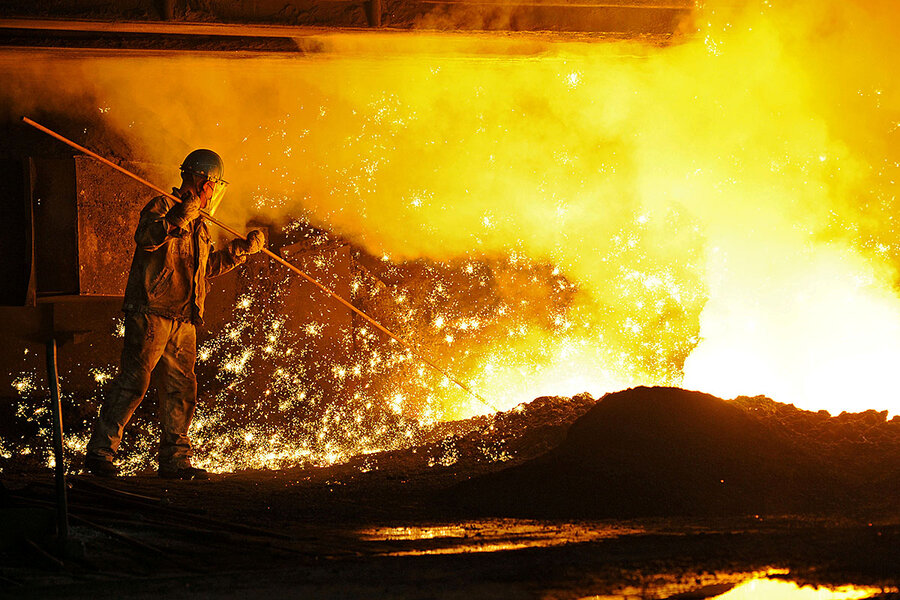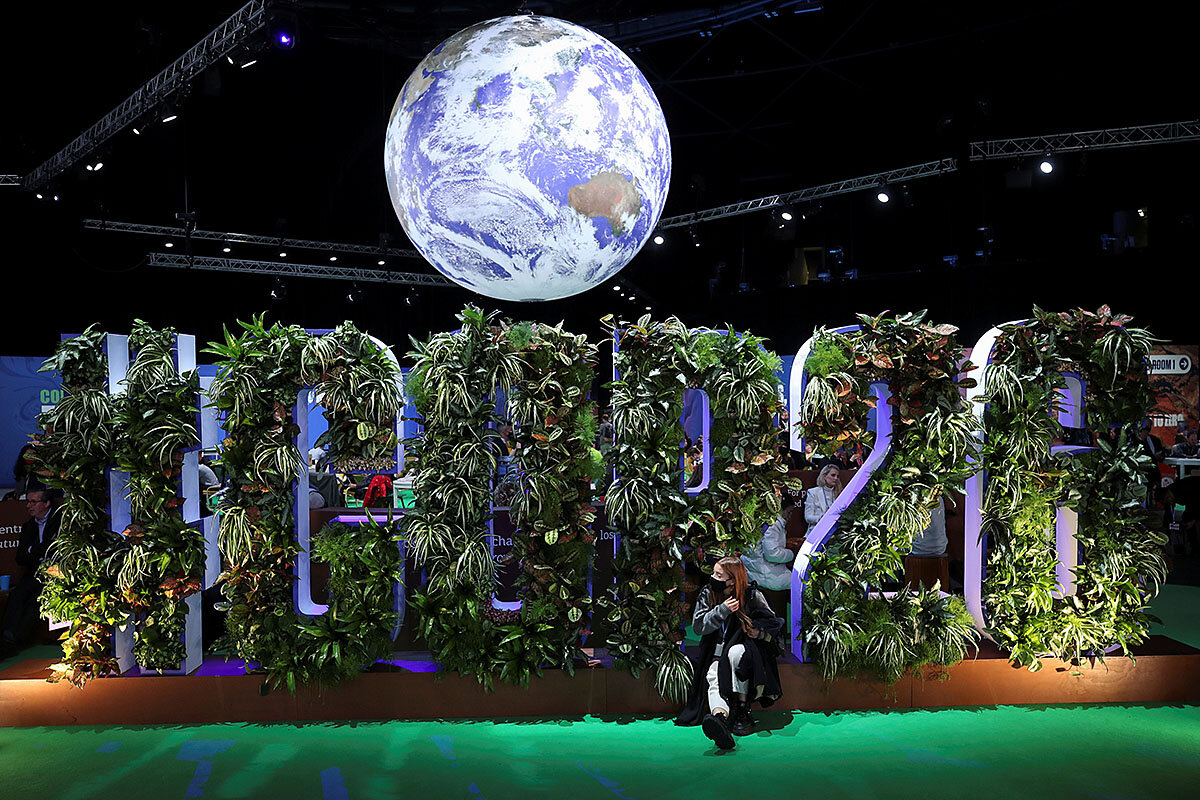Europe plans border tax on carbon. Will others join the club?
Loading...
What happens when one trading power is trying to drive down carbon emissions, and other nations aren’t moving so fast? That’s a hot question for the European Union, which makes its heavily polluting industries pay for their pollution while many other countries don’t.
Leaders in the EU have long argued that it’s time to level the playing field. Now they have a plan to use their market power to bring others into line.
The penalties they envision might have a side benefit for Earth’s climate by nudging other countries to ratchet down their own emissions.
Why We Wrote This
The COP26 global climate summit is, by design, about bargaining and voluntary steps, not mandates and penalties. But Europe is poised to add a tough-love tactic on the side. Will it help?
A key goal is to fix what is now a “leaky” system. Inside the EU, there’s a robust carbon market with rules and prices that push industries to reduce pollution. But goods imported from outside don’t typically face such constraints.
The EU’s proposed answer is a carbon border adjustment mechanism (CBAM), effectively an import levy on carbon-intensive products. The proposal, released in July, forms part of a strategy to cut EU-wide emissions 55% by 2030. The goal is to incentivize companies to invest more in green technologies, both in Europe and overseas, by driving up the cost of polluting.
It’s an idea to drive market-based carbon accountability that could someday reach far beyond Europe. John Kerry, the White House special climate envoy, has said President Joe Biden wants to evaluate Europe’s CBAM and that the United States could deploy its own border adjustment tax.
By going first, the EU may bring others along later, creating a club of developed economies that put a price on carbon and penalizing those that don’t. That would speed up the clean energy transition that is essential to break the buildup of heat-trapping gases in Earth’s atmosphere.
“There are a lot of people who see this as a way to build coordination among like-minded nations with similar levels of ambition who are ready to play by similar rules,” says Christopher Kardish, an adviser to Adelphi, an environmental consultancy in Berlin.
Such a club would reside outside the consensus-based, voluntary process at the United Nations climate conference in Glasgow, Scotland. Yet the CBAM is certain to be discussed on the sidelines, particularly between EU members and their trading partners.
What exactly is the EU proposing to do?
From 2023, EU importers of industrial products such as steel, aluminum, and cement would start assessing and reporting their imports’ overseas carbon footprint: put simply, how much carbon was emitted to make the product. The next step in 2026 would be to tax the emitted carbon under the market price in Europe that domestic producers must pay.
The idea is to prevent leakage, whereby strict standards in one jurisdiction cause production to shift to places with laxer rules. Already, around one-quarter of Europe’s emissions are embedded in the goods it imports, according to a study by the Boston Consulting Group.
“More emissions are occurring in other countries to meet the demand [in Europe] for consumer goods,” says Michael Mehling, deputy director of the Center for Energy and Environmental Policy Research at the Massachusetts Institute of Technology. He notes that Switzerland now imports more embedded emissions in goods than it emits domestically.
And European companies that are paying higher prices for carbon permits – hitting $70 per ton in October – don’t want to be at a competitive disadvantage to imports, says Mr. Kardish. “They’re facing a real bite in a world where they’re the only ones pricing carbon at that level,” he says.
Crucially, imports into Europe from countries that also price carbon would benefit under a CBAM. That’s because importers of steel, for example, made in California, one of several U.S. states that operate carbon markets, could deduct what was already paid there. Importers from countries that don’t tax carbon, however, would pay the full amount.
What are the implications for international trade?
Europe’s CBAM could transform the market for carbon-intensive products. It may also help to turbocharge investment and innovation in greener ways of producing those products, either in Europe or other regions that run carbon markets. By contrast, countries that don’t tax carbon would be at a disadvantage in selling into the world’s richest economic bloc.
Some critics question whether the CBAM is compatible with international trade rules, or represents a form of protectionism.
At the very least, a thorny question for EU regulators is what to do about countries that have policies to curb emissions, such as clean energy standards, but don’t put a price on carbon. In 2010, a bill to create a federal emissions-trading system like Europe’s failed to pass the U.S. Congress, and proposals to include a carbon tax in the Democratic social spending bill were dropped.
“If it’s not an explicit price, either from a tax or a mandatory carbon market like California has, it’s not going to be a cost that can be counted” toward paying a border tax, predicts Mr. Kardish.
While many countries have introduced carbon markets, most emissions aren’t subject to caps and prices vary greatly. Studies have shown that only when carbon prices are sufficiently high do they lead to changes in investment and production that lower emissions. Around 16% of all greenhouse gas emissions are currently covered by carbon markets.
Could this be the basis of a new global approach to climate?
A European border tax that recognizes other countries’ emission markets would be a step toward creating a carbon-pricing club that runs parallel to U.N.-brokered emissions cuts. Proponents say this club could raise the climate ambition of other countries that aspire to join and funnel more investment into renewable energy to produce tradable goods.
By penalizing countries that don’t put a price on carbon, though, an EU-led club could undercut the U.N. Framework Convention on Climate Change, which 197 countries have signed and is the basis of the 2015 Paris accord. Under that accord, countries effectively chose their own speed to cut emissions and build a low-carbon economy.
Absent U.S. support, there may be doubts about the long-term effectiveness of such a club. Another question is how the EU cooperates with China, which recently launched an emissions trading market that only covers domestic power generators. Many wonder if China would want to join a club in which EU regulators are determining the basis of carbon pricing.
Such doubts won’t stop European policymakers from rolling out a CBAM, says Mr. Mehling, who notes that Germany’s incoming coalition government is bound to be supportive. “It’s popular and populist: ‘We’re doing what you elected us to do and we will hit anyone outside the country that’s trying to undermine it,’” he says.







